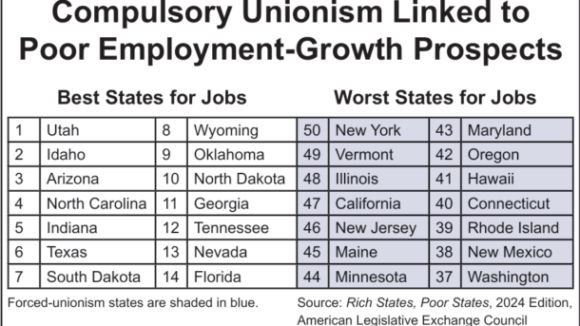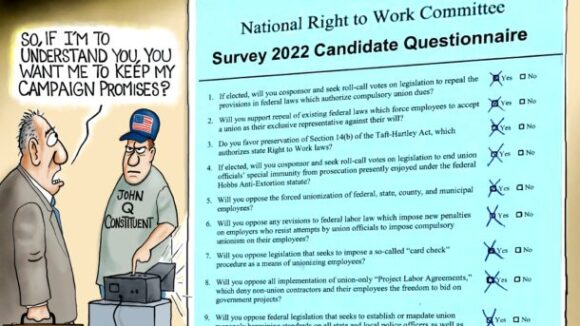Is This Any Way to Run a City’s Schools?
Leaked CTU Proposals Won’t Do Anything to Improve Schools’ Poor Performance

Recently updated federal data on the American workforce and employment show that employer demand for college-educated employees rose at a surprisingly rapid clip from 2011 to 2021, despite generally sluggish economic growth during the Obama years and the severe, COVID-19-related downturn of 2020.
Over the entire decade, the total population of the U.S., aged 25-64, grew by just 3.9%, but the number of people in that age bracket with at least a bachelor’s degree grew by 26.5%!
And, as of last October, according to the U.S. Bureau of Labor Statistics, the seasonally adjusted labor force participation for civilians aged 25 and over (including people 65 and over) with one or more higher-education degrees was 72.8%.
That’s 8.3 percentage points higher than the overall labor-force participation for people in that age bracket.
Also in October, the nationwide seasonally adjusted unemployment rate for college-educated adults 25 and over was just 2.1%, compared to 3.1% for the 25-and-over workforce as a whole.
The bottom-line significance of these data is employers across the country typically have more difficulty finding a qualified college-educated person to fill a position than a college-educated person has finding a good job.
Of course, not everyone who holds a bachelor’s degree and is in the workforce is doing well economically. But generally speaking, it is still a “seller’s market” for college-educated labor in America today.
Furthermore, many businesses that sustain large numbers of jobs for people with associate’s degrees, high school diplomas only, or less education also require a substantial number of college-educated people to operate efficiently.
Therefore, the rate at which a state is gaining college-educated people, relative to the national average, is in itself a good measure of how successful the state is in creating and retaining good jobs.
According to this important criterion, states that still lack Right to Work protections for employees are performing quite poorly, as U.S. Census Bureau data show.
Forty-five states were either Right to Work or forced-unionism for the entire period from 2011 to 2021.
Among these states, the seven with the greatest percentage gains in their working-age, college-educated population over that period — Florida, Idaho, Nevada, North Carolina, South Carolina, Tennessee and Texas — are all Right to Work states. Ten of the 12 top-ranking states are Right to Work.
On the other hand, 12 of the 16 states with the lowest percentage growth in their college-educated populations, aged 25-64, from 2011 to 2021 are forced-unionism states.
Right to Work states with rapidly growing college-educated populations are culturally as well as regionally diverse.
In the aggregate, the 22 states with longstanding Right to Work laws experienced a decade-long percentage gain in their college-educated, working-age populations of 33.6%, roughly half again as great as the average increase for the 23 remaining forced-dues states.
“The simple fact is, highly educated employees, like other employees, benefit from Right to Work laws,” said National Right to Work Committee Vice President John Kalb. “Employees of all kinds prefer to live in Right to Work states when they can because living costs are lower and real incomes are higher.”
Mr. Kalb cited two recent analyses by the National Institute for Labor Relations Research.
One drew on data from the Census Bureau and the Missouri Economic Research and Information Center, a state government agency, to calculate that, as a group, the 23 forced-unionism states were nearly 25% more expensive to live in than the 27 Right to Work states in 2022.
The other found that the average cost of living-adjusted, after-tax income per capita in Right to Work states that year was $55,320, roughly $3,700 higher than the forced-dues state average.
Mr. Kalb concluded: “The Institute’s analyses reinforce what the Census data already show: Forced-unionism states seeking a ‘brain gain’ should pass Right to Work laws.
“The data show this is a much more effective way for a state to attract additional educated workers than jacking up subsidies for the already heavily subsidized higher education system. Policymakers in states that still lack Right to Work protections for workers should pay heed.”
This article was originally published in our monthly newsletter. Go here to access previous newsletter posts.
To support our cause and help end forced unionism, go here to donate.

Leaked CTU Proposals Won’t Do Anything to Improve Schools’ Poor Performance

Wherever Big Labor wields the power to collect forced union dues, union bosses funnel a large share of the confiscated money into efforts to elect and reelect business-bashing politicians. Employment growth tends to lag as a consequence.

Members Insist They Keep Pro-Right to Work Campaign Promises